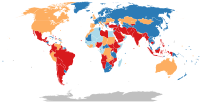
Photo from wikipedia
Objective This study aims to compare the effect of blended teaching and traditional teaching in higher medical education during the pandemic era. Methods Taking the teaching of neurology as an… Click to show full abstract
Objective This study aims to compare the effect of blended teaching and traditional teaching in higher medical education during the pandemic era. Methods Taking the teaching of neurology as an example, 293 Yangzhou University Clinical Medicine 2016 undergraduate students were selected as the research subjects, and were randomly divided into 2 groups a blended teaching group (n = 148) and a traditional teaching group (n = 145), and received blended teaching and traditional teaching, respectively. The blended teaching was based on a Massive Open Online Course, problem-based learning, and case-based learning and supplemented by Tencent video conferences, QQ messaging groups, and other auxiliary teaching tools. At the end of the course, the teaching effect and satisfaction rate were evaluated through theory assessment, practical skills assessment, and an anonymous questionnaire survey. Results There were significant differences in theoretical achievements (81.83 ± 6.23 vs 76.79 ± 6.87, P < 0.001) and practical skill achievements (84.74 ± 6.50 vs 78.48 ± 6.53, P < 0.001). In addition, significant differences in all aspects of satisfaction rate were observed between the two groups (all P < 0.001). Conclusion Blended teaching is beneficial to students' learning and stimulates their enthusiasm, cultivates clinical thinking ability, and improves teaching quality. Thus, it has played a positive role in the reform of higher medical teaching during the pandemic era.
Journal Title: International Journal of Clinical Practice
Year Published: 2022
Link to full text (if available)
Share on Social Media: Sign Up to like & get
recommendations!